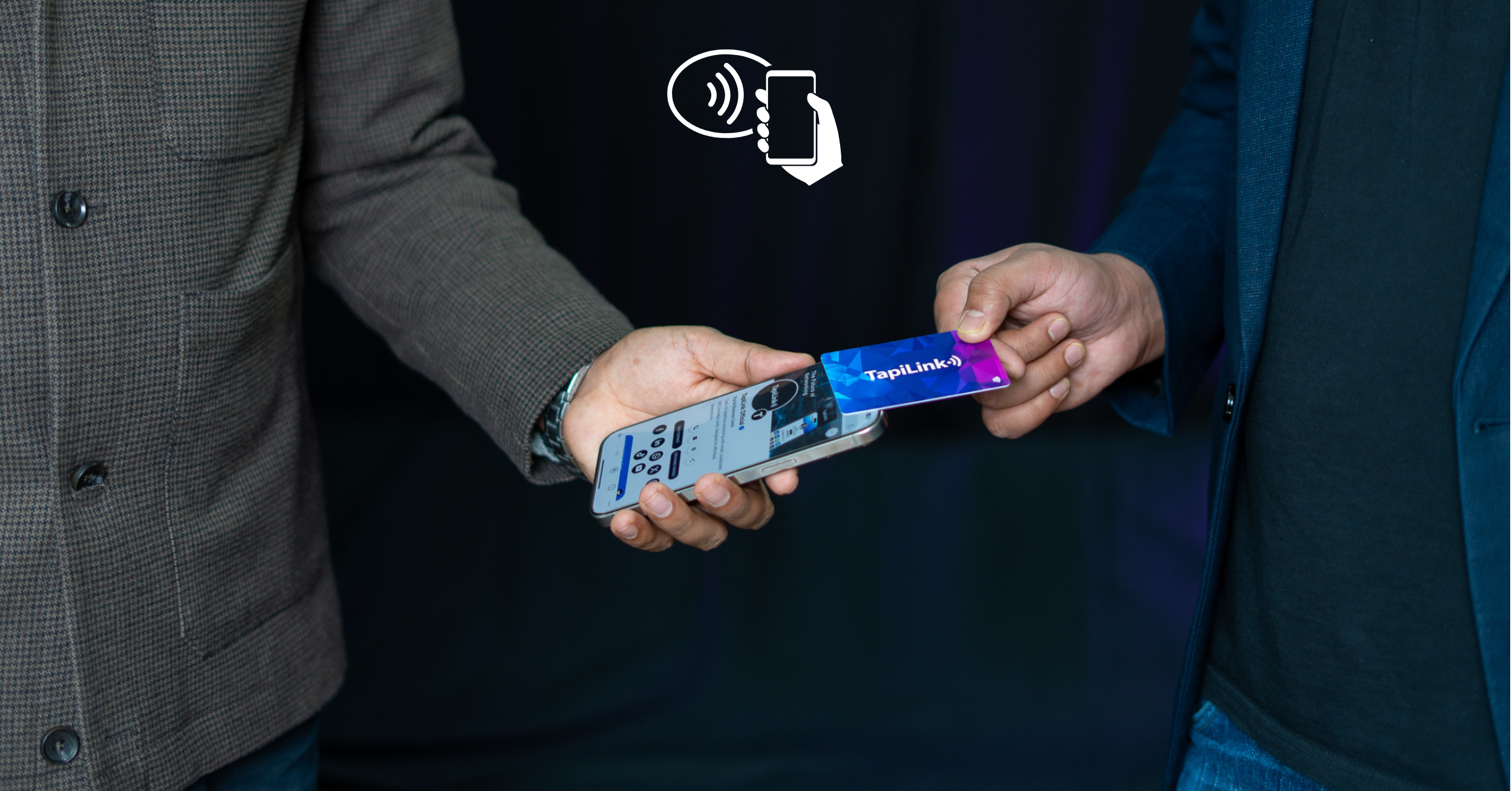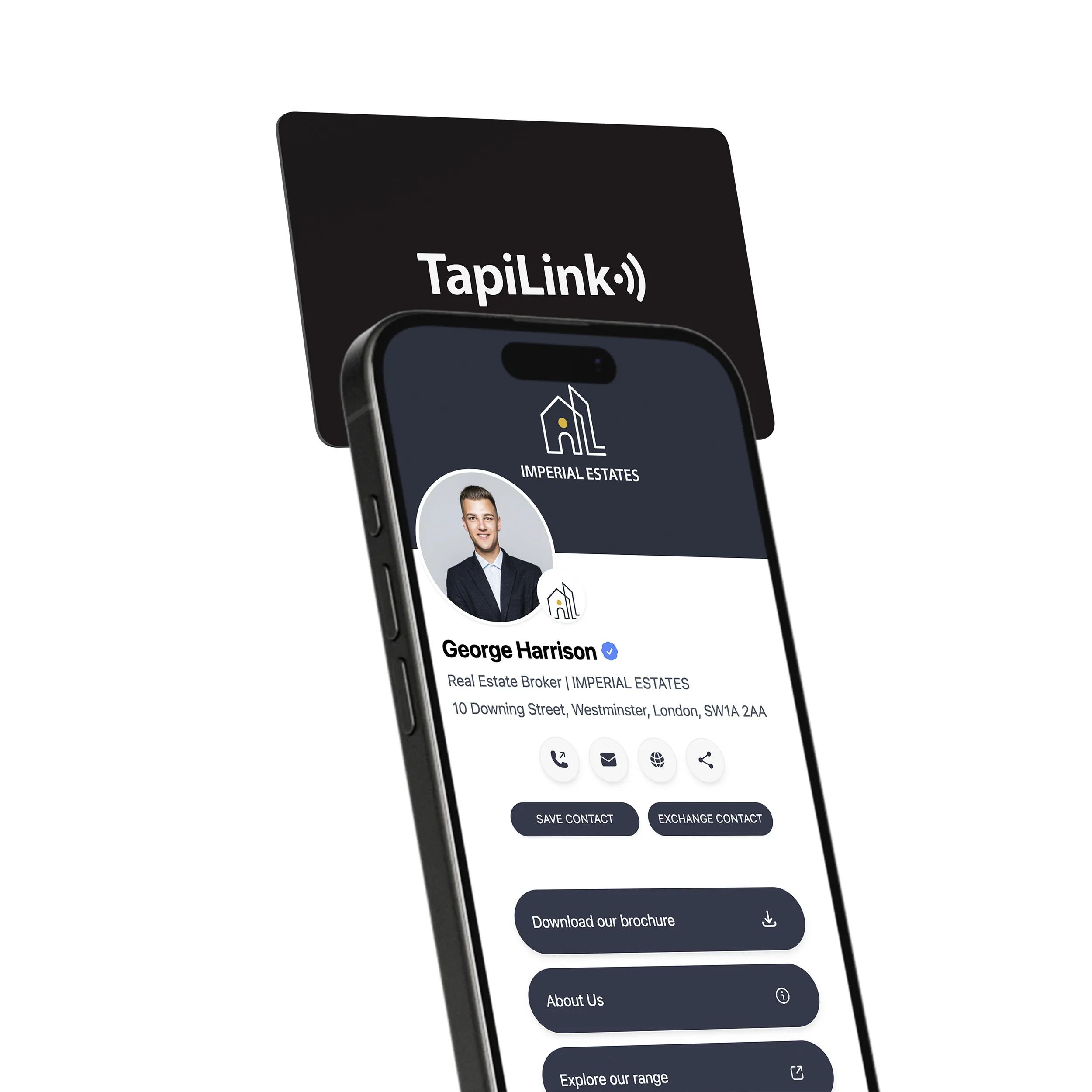Subscribe To Our Newsletter
Join our 50,000+ happy customers
[mc4wp_form id=""]
We’ll Design 🎨 Your Card For Free!
Free Next Day 📦 Delivery in UK
We Ship Worldwide 🌎 ✈️

Have you noticed how often you tap your phone these days? From grabbing a coffee to hopping on the train, NFC has become part of everyday life. An NFC tag is used to store and share information instantly. It can easily be used as a digital business card, to make payments, unlock access control, and even in healthcare. In simple words, it’s a tiny chip that stores data and responds instantly when you scan it with your phone’s NFC reader.
Even some years ago, it was impossible to share your information without paper. But now NFC has made everything much easier. It’s battery-free, secure, and even eco-friendly when made from recyclable materials.
And if you want to put this tech to work for your networking or business, Tapilink makes it effortless, helping you share, connect, and impress with just one tap.
Ever tapped your phone to pay for coffee or to hop on the Tube? If you have, you’ve already used the same tech that powers an NFC tag. At its core, an NFC tag is a tiny smart chip with an antenna, kind of like a hidden helper that springs to life when your smartphone gets close.
The tag itself doesn’t need charging or batteries. Instead, your phone’s NFC reader sends out radio waves that power the tag, which then shares its data instantly. That data might be a link, Wi-Fi details, or even card information for mobile payments like Apple Pay and Samsung Pay.
But NFC tags aren’t just about paying for things. You can use them as digital business cards, set them up for access control, or even program them to run shortcuts that make your smart home or daily routines easier.
Do you know what actually happens when you tap your phone to pay or scan a smart tag? Behind the scenes, it’s surprisingly simple. An NFC tag is a small chip with an antenna that acts like a tiny radio station. On its own, it’s completely passive, no battery, no power.
When you bring a smartphone or another NFC-enabled device close, usually within 2–4 cm, your phone’s NFC reader sends out radio waves. These waves energize the tag, which then activates and shares the data stored on it using the NFC Data Exchange Format (NDEF).
That data could be a web link, Wi-Fi login, or card details for Apple Pay, Samsung Pay, or other mobile payments. Because the scan distance is so short, the process is quick, secure, and feels almost instant, making everyday tasks like payments, scanning digital business cards, or unlocking a smart door effortless.
This one’s a game changer. Forget carrying stacks of paper cards that people often lose or toss aside. With a digital business card powered by NFC, you just hand over your card, and the other person taps it with their mobile phone. Instantly, your details, LinkedIn, or even your portfolio are saved in their contacts.
It feels futuristic, but it’s super practical. You can update your info anytime without printing new cards, and if you’re eco-conscious, it’s a win for the planet too, since it reduces the use of plastic and lowers the carbon footprint of any business.
Picture this: you’re at the café, coffee in one hand, phone in the other. Instead of digging around for your wallet, you just tap your phone at the till with Apple Pay or Samsung Pay, and you’re done in seconds. That smooth tap is powered by an NFC tag and an NFC reader working together behind the scenes.
If you’ve ever jumped on the Tube in London, you’ve probably used TfL Express Mode without even thinking about it. Just tap your smartphone on the gate and walk straight through, no messing with tickets or Oyster cards. That’s NFC making city travel quick and painless.
NFC can also make your routines easier. Imagine tapping a tag by your bed that puts your phone on silent, or one in your car that flips on Bluetooth the moment you hop in. You can even set a tag by the front door that connects your phone to Wi-Fi when you walk in. Because many are rewritable NFC tags, you can keep switching things up as your habits change.
Think about your office or gym. Instead of fumbling with plastic cards, you just tap the tag or your phone to open the door. Businesses use NFC and RFID tags for secure access control, and some are even moving to recyclable NFC tags to cut down on plastic waste.
Ever seen a product with a “Tap here” symbol? Shops are using smart tags so you can scan the tag with your phone to check reviews, get instructions, or unlock special offers. Behind the scenes, NFC tags are used to track products in warehouses, making stock checks way more accurate.
At concerts and sports games, NFC makes entry fast. Instead of paper tickets, you just tap your phone or a wristband at the gate and you’re in. No queues, no paper waste.
In hospitals, NFC tags are quietly saving lives. They’re used on wristbands and medical equipment so staff can check the right info instantly, making patient care safer and faster.
And here’s the bonus: recyclable NFC tags are helping businesses ditch plastic cards and tickets. It’s about convenience, also about lowering the carbon footprint of any business while staying modern and secure.
1. Just tap your smartphone to an NFC tag. No typing or swiping. Perfect for contactless payments with Apple Pay or Samsung Pay, or logging into Wi-Fi in seconds.
2. With rewritable NFC tags, you can change their function anytime. Share a digital business card, unlock access control, or set one to toggle Bluetooth at home.
3. Because NFC and RFID work at a very short range (2–4 cm), your card details and data stay safe. That’s why NFC powers trusted mobile payment systems.
4. Switching to recyclable NFC tags helps reduce plastic use and cut the carbon footprint of any business.
5. Most modern NFC-enabled smartphones already support it. Just scan the tag with your NFC reader and it’s ready to go.
Instead of handing out paper business cards or typing the same details again and again, you can let an NFC tag do the work for you. With a quick tap of your smartphone’s NFC reader, the tag can instantly share information, trigger actions, or even open your Tapilink profile.
1. Get your tags – Start with blank or rewritable NFC tags. If you want an eco-friendly option, choose recyclable tags.
2. Use the right app – On Android, apps like NFC Tools are easy to use. On iPhone, the Shortcuts app makes setup simple.
3. Pick the action – Program the tag to share your digital business card through Tapilink, connect to Wi-Fi, toggle Bluetooth, or set up access control.
4. Write the data – Hold your phone near the tag and follow the steps to save your chosen action.
5. Tap to use – The next time you scan the tag, your phone instantly runs the task, whether it’s opening your Tapilink page, launching an app, or completing a mobile payment with Apple Pay or Samsung Pay.
The future of NFC tags is about making everyday life even easier. Today, most people know NFC from contactless payments with Apple Pay or Samsung Pay, but that’s just the start. Soon, your smartphone’s NFC reader will be able to do even more, like turning on Bluetooth, connecting to Wi-Fi, or starting your favorite apps with a single tap.
NFC is also changing how we share information. Instead of carrying paper cards, you can use digital business cards. With services like Tapilink, one tap lets people save your details, visit your website, or follow you on social media.
Businesses are adopting NFC too, especially for access control, tickets, and healthcare solutions. And with recyclable NFC tags, companies can cut down on plastic and lower their carbon footprint while still staying modern and efficient.
Answer: An NFC tag is used to store and share small amounts of data when scanned by a smartphone. Common uses include contactless payments, digital business cards, access control, Wi-Fi sharing, and smart home automation.
Answer: Most modern smartphones come with an NFC reader built in. iPhones (from iPhone 7 and later) and most Android phones can scan NFC tags for payments, sharing data, or running tasks.
Answer: NFC tags work at a very short range, usually 2–4 cm. This close scan distance keeps the connection quick and secure, making NFC ideal for mobile payments and data sharing.
Answer: Yes. Many rewritable NFC tags can be programmed multiple times with different tasks. Some tags are read-only, meaning the data cannot be changed once written.
NFC tags may be tiny, but they’re incredibly powerful. From paying for your morning coffee with Apple Pay or Samsung Pay, to instantly sharing your digital business card, or even automating everyday tasks like turning on Bluetooth or connecting to Wi-Fi, they make life smoother with just a tap. Plus, with rewritable and recyclable NFC tags, they’re flexible, secure, and better for the planet too.
Looking ahead, NFC is only going to become more useful in how we live and work. And if you’re curious about trying it yourself, Tapilink is a simple way to get started. Helping you connect, share, and make a lasting impression in seconds.
Join our 50,000+ happy customers
Copyright © 2025 TapiLink, made with ❤️ in United Kingdom. TapiLink is a trading name of SERVICEWORLD LIMITED (company number: 13239157), whose registered office is at 34 Green Street, London, England, E7 8BZ

Subscribe to our newsletter below and get 10% exclusive discount on your first order.